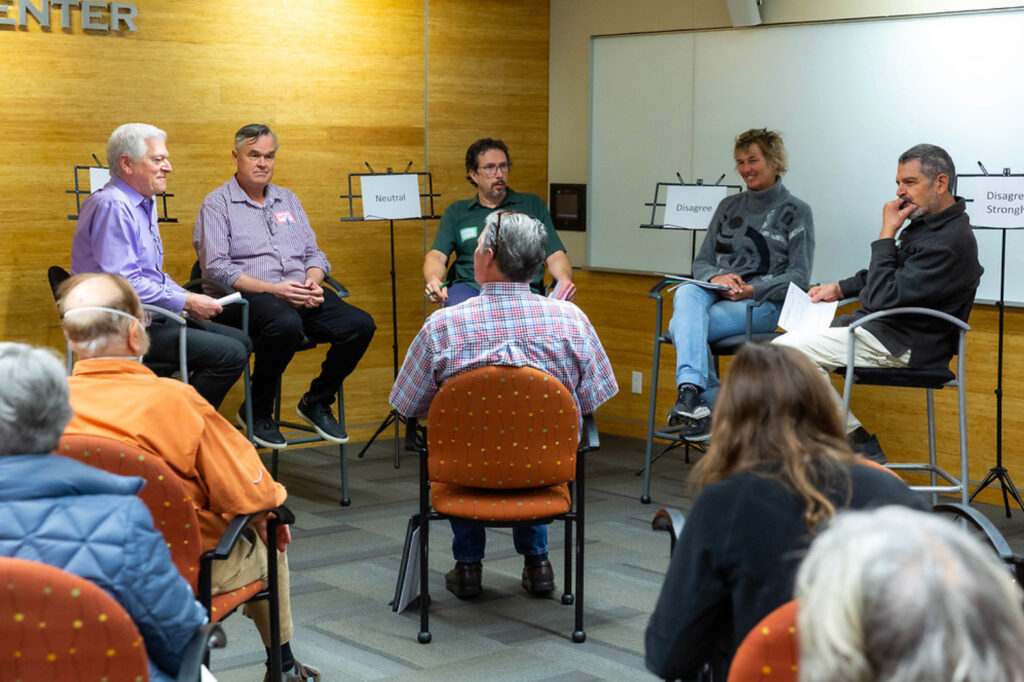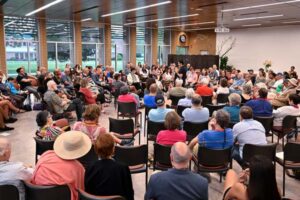Many people avoid having fights over dinner. But two Braver Angels alliances—one in Northern California, the other in Southern California—took a chance and invited people to come to a shared meal and present passionately held ideas on challenging topics. To do that, the two alliances partnered with Fighting to Understand, a nonprofit organization that hosts conversations based on a framework called “Dinner and a Fight.”
The “Dinner and a Fight” concept originated with Ted Wetzel, a businessman who lives in Ohio. “I was living a life of ‘ask what my country can do for me,’ and at the age of 55, I had a wake-up call,” Ted said. He and his wife had gone out to dinner with long-time friends, and the conversation turned to politics, then blew up into a ferocious fight. “It didn’t get physical,” Ted recalled, “but we didn’t have the skill to get beyond the argument.”
Troubled by what had happened, and by what it meant in a larger societal sense, Ted began exploring how to foster better communication between people who have different opinions. At a conference on civility, he was introduced to the five-chair method of dialogue. In the book Hot Topics, Cool Heads: A Handbook for Civil Dialogue, authors Clark D. Olson, Jennifer A. Linde and John Genette describe the five-chair model as a process in which a controversial topic is introduced, and five people array themselves along a spectrum of opinions about the topic, then share their perspectives. Wetzel adopted the model, then combined it with the social element of food and named it “Dinner and a Fight” (except that the word “fight” is crossed out and replaced with the word “dialogue.”)
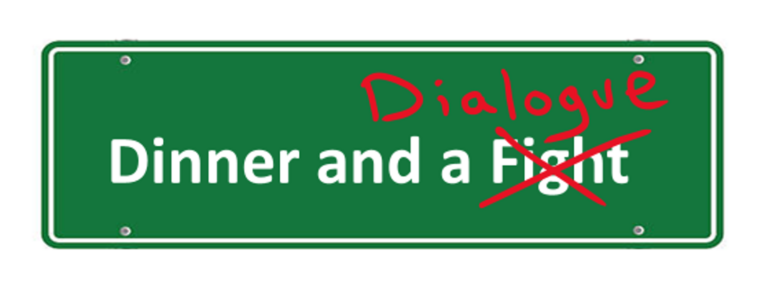
“We find that so many people are hungry for this kind of deep interaction and truly want to understand and connect with others who have a different viewpoint.”
Wetzel said that he has been asked more than once if it’s necessary to use the word “fight” in the name of his events, but he added that most people who have that reaction change their mind after they experience an event. “They say, ‘Oh, I get it.’” He likes to use the metaphor of a road trip that all the participants are on together, and the word “fight” serves as a Caution sign. “It shows them that this is hard work, that we have to take it seriously.”
Dan Messina, the Braver Angels Red Co-Chair of Northeast Ohio (Cleveland/Akron area) has attended five of Wetzel’s “Dinner and a Fight” events. He explains that when attendees arrive at one of Wetzel’s events, they find a hall filled with dining tables. Each person finds a table, with the one rule being that you can’t sit at a table with anyone you know. Once all the chairs are filled, the attendees get their dinner and start chatting, guided by thought-provoking but non-controversial icebreaker questions.
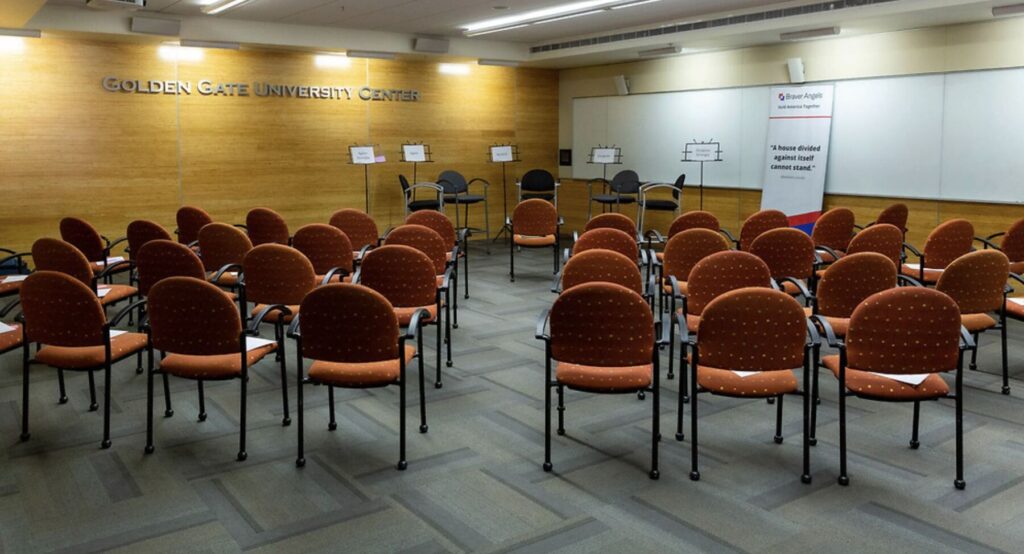
After dinner, the five-chairs portion of the evening begins: on a stage, five chairs are set up with a sign in front of each one: “Strongly Agree,” “Somewhat Agree,” “Neutral,” “Somewhat Disagree,” and “Strongly Disagree.” Ted introduces a divisive statement, and then audience members can volunteer to sit in the chair that reflects their opinion on the statement. When the five chairs are all filled, the conversation begins. “Usually the first question is, ‘Why did you take the chair you did?’” Dan said. Then for about 15 minutes, a moderator (usually Ted) allows the five volunteers to explore the provocative topic through dialogue. For another 25 minutes, the audience can offer perspectives and pose questions to further illuminate facets, exploring the topic further.
“They may be passionate at times, but I’ve never seen anyone yell at anybody, I’ve never seen any fistfights. It’s never devolved into that.”
The attendees then return to their original tables to have dessert and continue discussing the topic at their own table. “It’s a little scary at first, if you haven’t done it,” says Daniel. “But I’ve done about five of these, and they’ve all been civil. They may be passionate at times, but I’ve never seen anyone yell at anybody, I’ve never seen any fistfights. It’s never devolved into that.”
Impressed by what he had experienced, Dan described “Dinner and a Fight” to Carlos Hernandez, then the Red Regional Lead for Braver Angels Pacific Region and the Red Co-Chair of the San Francisco Alliance, whom he knew from the Braver Angels Red Caucus.
“The more Dan talked about it, the more it made sense,” Carlos said. In San Francisco, a very Blue city, the Braver Angels Alliance struggled to attract Reds, despite the best efforts of Carlos and his Blue Co-Chair Ellen Sears. For Carlos, the word “fight” in the name was essential. “There’s a very different mindset between Reds and Blues,” he said. “Blues are more touchy-feely, very polite. They want to create a warm kumbaya kind of atmosphere. Reds are not that way, they’re repelled by that.”
“Blues are more touchy-feely, very polite. They want to create a warm kumbaya kind of atmosphere. Reds are not that way, they’re repelled by that.”
Word then spread to Braver Angels of Southern California leaders, including Dan Selz, LA Alliance Blue Co-Chair, and Susan Rico, SoCal Event Organizer. Dan and Susan were interested in the format’s ability to offer a chance to truly ponder different points of view. “We find that so many people are hungry for this kind of deep interaction and truly want to understand and connect with others who have a different viewpoint,” Susan said. “They’re deeply unhappy at the polarized state we find ourselves in as a country, and want to do something productive about it.”
In both Northern and Southern California, the alliances planned events with Wetzel, but each had their own variations. In San Francisco, the event became “Lunch and a Fight,” and in Southern California, it was “Brunch and a Brawl.”
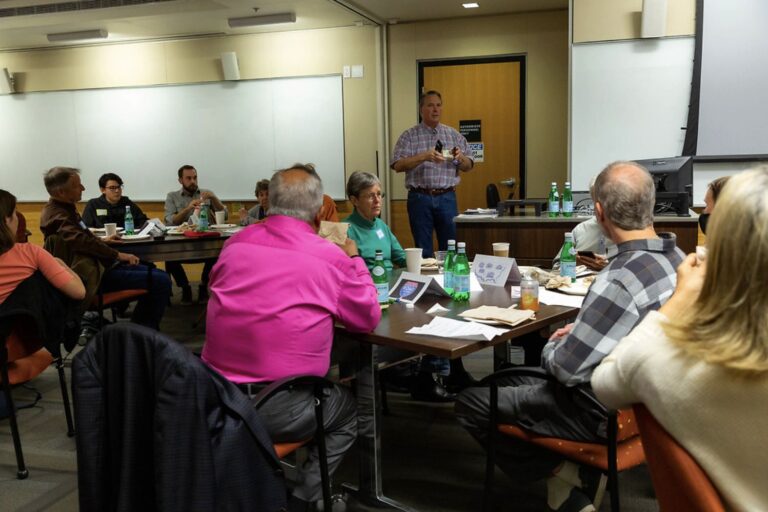
Thirty-five people attended the event in San Francisco, which was held in a meeting room at Golden State University. “We had a beautiful space, a lovely lunch—not pizza and soda pop out of a cooler,” Ellen said. “And people had to pay $40. The message there is, do not be afraid to charge. We have to use business thinking. Businesses don’t give things away. They sell them. When people pay money, they have greater expectations. There’s greater value to what you’re offering.”
“People had to pay $40. When people pay money, they have greater expectations. There’s greater value to what you’re offering.”
“The San Francisco team of Blues drove this,” said Carlos. “They’re not stereotypical Blues: they have run businesses. They want results, results, results. Numbers. If we don’t get butts in seats, you’re not going to have depolarization. It’s common business sense.”
In Los Angeles, Dan and Susan wanted as much as possible to get equal numbers of Reds and Blues. “We work very hard toward balanced participation in our events,” Susan said. The challenge is that in Los Angeles, people can be hesitant to admit that they consider themselves Red. “We find that many Reds don’t want to be ‘outed’ as such. It’s unfortunate, but stereotypes are very real, and people understandably don’t want certain labels attached to them. But really, everyone has a unique story to tell, and if we can create a space for those stories to unfold, we find that there is really no one type of ‘Red’ or ‘Blue.’”
The “Brunch and a Brawl” organizers decided to have two types of tickets, but to address the hesitancy that some Angelenos have to describe themselves as Red, the tickets were not labeled “Red” or “Blue.” Instead, attendees were asked to respond to a group of statements, some slightly Red-leaning, others slightly Blue-leaning. The sign-up process revealed that 16 of the attendees were right-leaning and 20 were left-leaning.. “We assigned tables to have at least two right-leaning people at each one,” Susan said. “We also had a wide range of demographics represented, which was wonderful to see! This format seems appealing to people from all ages and walks of life. It reflected America, which is one of our goals at Braver Angels.”
“Everyone has a unique story to tell, and if we can create a space for those stories to unfold, we find that there is really no one type of ‘Red’ or ‘Blue.’”
Dan Messina, the Ohio co-chair who was the connection between Wetzel and the Braver Angels Alliances in California, says one of the advantages to Wetzel’s format is the quality of conversations, which he believes has a lot to do with the statement that’s revealed. “It’s meant to polarize, it’s meant to instigate discussion. You want something that’s meaty, that people are thinking about.” In Northern California, the statement under discussion was “Equality of opportunity has been reasonably achieved”; in Southern California, it was the proposal, “Gender identity should be excluded from classroom discussions.”
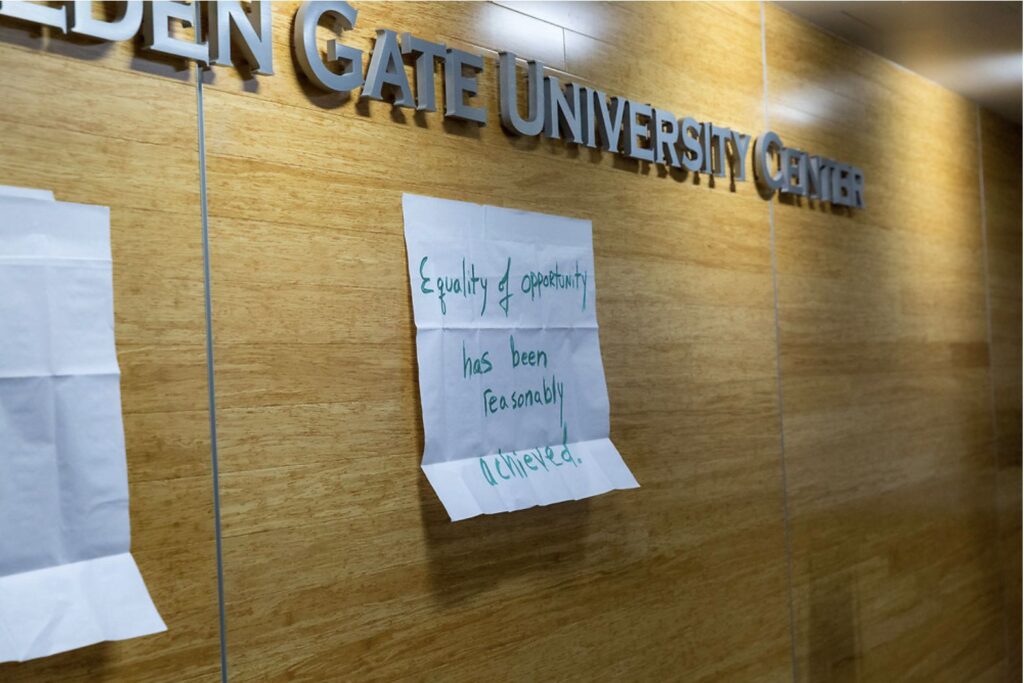
Carlos and Ellen observed that the configuration of the chairs in San Francisco wasn’t about Red/Blue divides. “Not all topics are necessarily Red/Blue,” Ellen said. “Equity vs. meritocracy isn’t about Red vs. Blue. You can have parents of kids in the school system and how their children are evaluated to get in, so all kinds of things that come into play don’t turn into Red/Blue.”
In Los Angeles, too, the conversation led to new understanding. The “Strongly Agree” panelist was a mother who has been very active in LA politics and education issues, while the “Strongly Disagree” panelist was another mother, who has raised a transgender son. “It was a really balanced group,” Susan said. “The panelists were all very open and thoughtful, and wove their own personal experiences into their points of view. There was no vitriol; in fact, quite the opposite. There was general good will, curiosity, and even some common ground discovered, in that we should teach our children to be more loving and accepting of those who are different.”
Carlos saw the “Dinner and a Fight” event as an extension of the work that Braver Angels is already doing. “I’m a big advocate of our workshops. They’re critical, especially our basic ones,” he said, likening them to a boxer’s training. “You have to know how to throw a punch. You have to know the art, the gracefulness, the footwork, before getting into a ring to talk about a tough topic.” Doing “Dinner and a Fight” with Ted offered the attendees the equivalent of a long-awaited boxing match. “I’m glad we met Mr. Wetzel, he helped us elevate our game.”
Ted himself mentions two possible applications for the “Dinner and a Fight” model that might be useful for Braver Angels groups. The first is using it as a way to continue working on skills—the gym metaphor that Carlos also mentioned. “It doesn’t matter what the topic is, as long as it’s juicy enough,” Ted said. The second application is using the model to address a specific problem, perhaps as a substitute for town hall meetings. “In that case, we would advertise the topic,” Ted said, adding that sharing the topic ahead of time is something his organization has rarely done, and would be a next step for them. But the Dinner and a Fight process is meant to evolve, along with the conversations it helps facilitate. “Hopefully, we can use this tool to move forward. And at some point, the tool may become obsolete.”
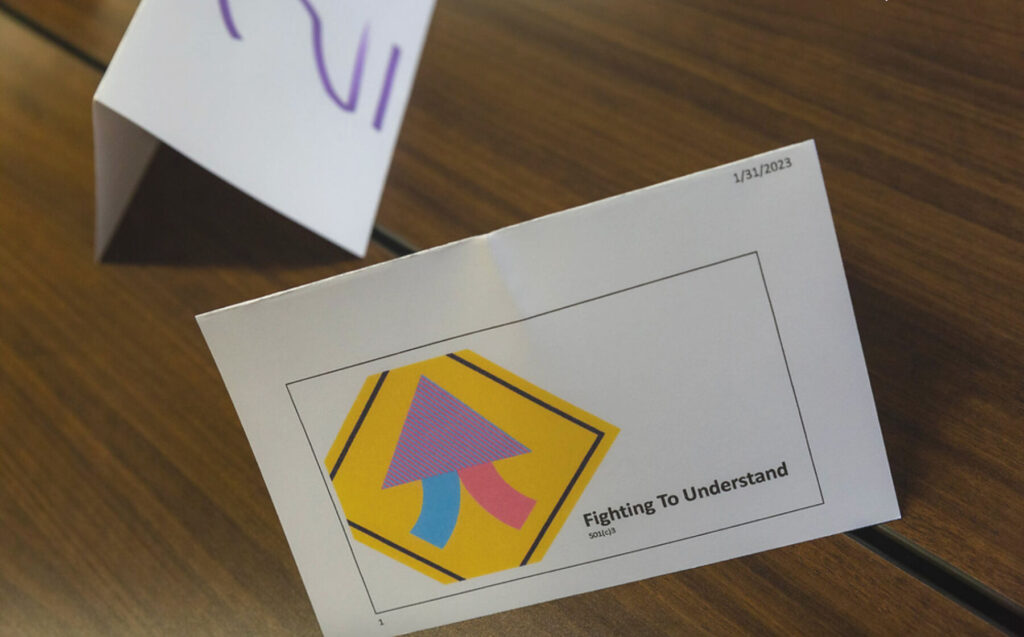
Carlos and Ellen suggested that there are two important lessons other Braver Angels groups can take away from their experience with Ted Wetzel and Dinner and a Fight. First, there are many nonprofits that could partner with Braver Angels alliances for events and other collaborations. “There’s strength in numbers,” Ellen said. “Nobody is in this alone. You have to be willing to work with others. It does nothing but make it a better experience and a better result.”
And even more importantly, she said, alliances shouldn’t be afraid to take on something new. “You can be creative in planning discussions and events. Don’t worry that you’re breaking a rule. That’s the most important message that comes out of this: don’t be afraid, take a chance, do something bold, be provocative. It’ll all work out.”
For more information on Fighting to Understand, visit the organization’s website at fighting-to-understand.us.
To suggest more stories we could report about the Braver Angels community, please submit a story idea here.

